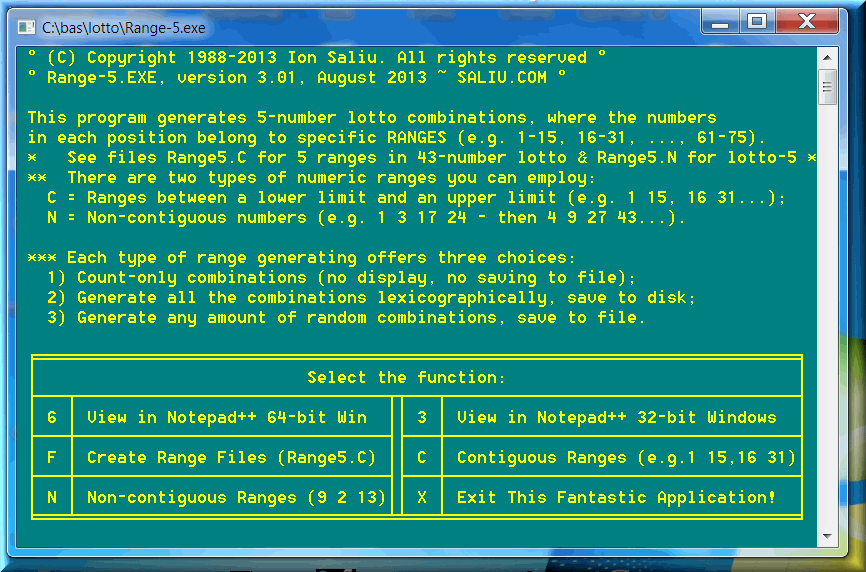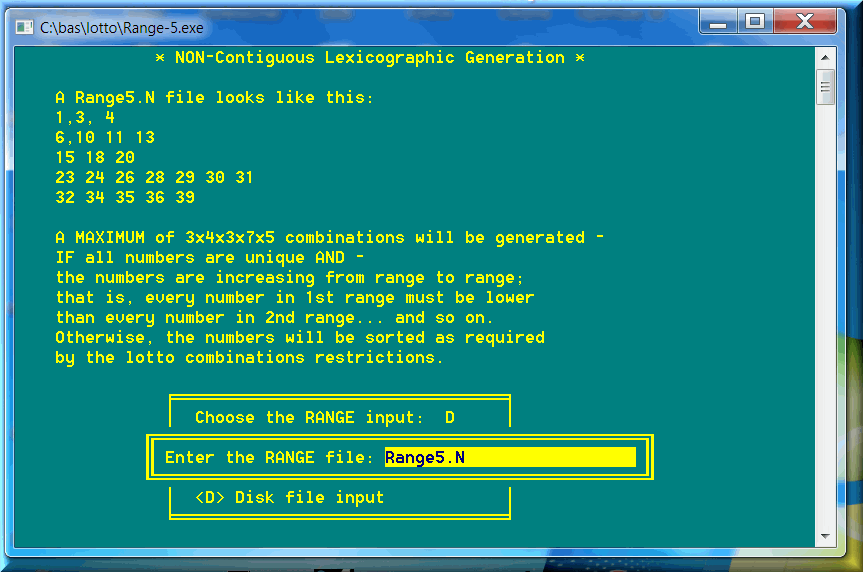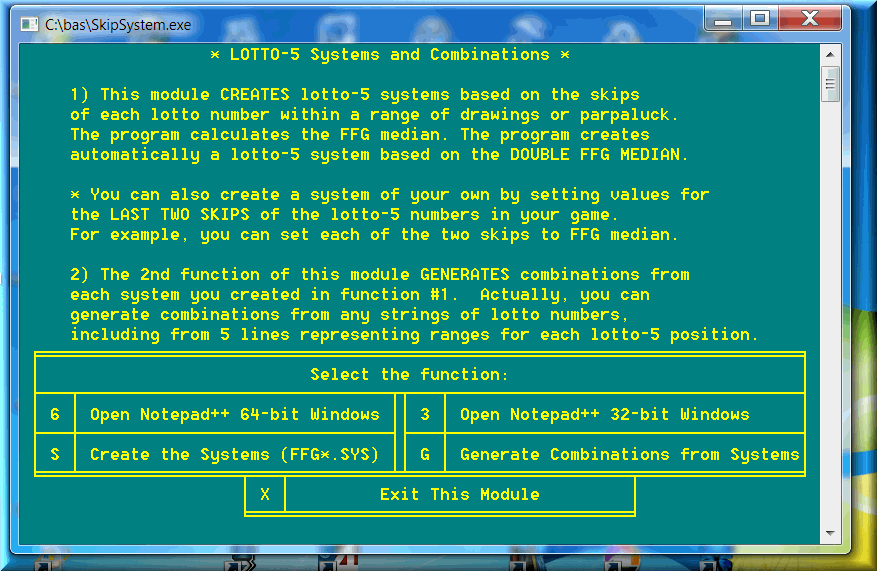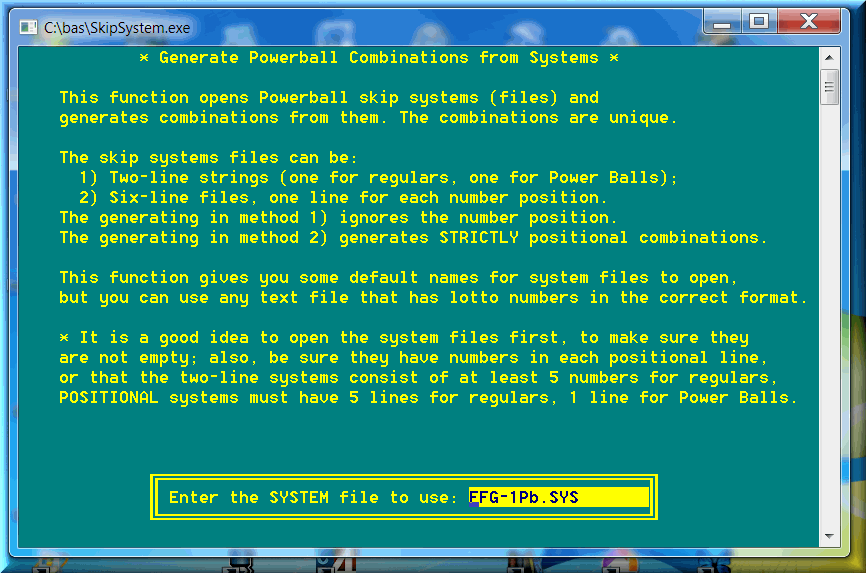
Lottery Strategy by Lotto Software on Positional Frequency
By Ion Saliu, ★ Founder of Lottery Software Science



Indelibly-Axiomatic Colleagues of Mine:
There is one piece of grandiose lottery software well-known around the world; it is used a lot more illegally than legitimately. I got my instincts and also antennae! I am referring here to FrequencyRank.
The program generates frequency reports two ways:
1.- Regardless of position;
2.- Position by position.
The numbers are ranked by frequency in descending order, from hot to cold.
Some of the most respected lotto software packages out there consider their strength to be the number frequency as plotted by method #1 in FrequencyRank. Then, said software packages offer to the user the so-called best numbers to play: Usually, the top half of the lotto numbers based on frequency. I showed on several Web pages how weak that lottery strategy is.
It is infrequently that the winning lotto numbers come from the top-half of the hot numbers!
How about a strategy based on positional frequency, as worked out by the function #2 in FrequencyRank? I believe it is a much more effective method of lottery number reduction. I did a test based on Pennsylvania 5-43 lottery game.
I ran Frequency Rank with the data file before the latest 5/43 lotto drawing I had downloaded: 10 15 17 3 40. I marked the winning numbers in the reports, and then I counted the respective frequency ranks.
Here is the situation for the regardless of position analysis:
Here is the situation for the position by position analysis:
The regardless of position analysis indicates a bad strategy as in the ordinary lotto software packages that ask you to pay with an arm and a leg. As I already pointed out many times now, it is best to reverse such lottery strategy and employ it as LIE elimination.
The position by position analysis indicates a better lotto strategy — it is not present in the ordinary lotto software packages. I copied the top 10 numbers in each position and created a simple text file with 5 lines. Such file should generate 10 ^ 5 = 100,000 lotto-5 combinations — at the maximum. Some numbers are common (e.g. 4, 5, 7, 9 for positions 1 and 2), therefore fewer combinations will be generated. In fact, I ran Bingo 75 and the program generated 87,476 combinations.
We can further reduce that amount of combosnations by applying my unique LIE elimination method. We will apply the method to the output file with those 87,476 combinations.
Let's look at the top-10 in the regardless of position report. There is only one winning lotto number in that range. Therefore, we can apply the ID2 filter in the LIE elimination function of Bright5. That ID2 alone could reduce all 87,476 combinations! Of course, several combinations overlap, so we will still be left with more LIE elimination work to do.
All 5 winning numbers are not in the top 40 numbers of the lotto game. Therefore, we can generate combinations from 40 numbers saved to a one-line text file. We can use Make / Break in Super Utilities, or BreakdownNumbers. We got something easier to calculate now. Total combinations C(40, 5) = 658,008. That's how many combinations the Lie ID5 filter would eliminate at a maximum. Of course, many combinations overlap! But the final result would be a handful of combinations to play — if any! Because there will be cases when this lottery strategy will not hit — thus we save money.
The software is not ready to automate the task to higher degrees. The lottery software to generate the combinations is available. But the reporting software is not there. We need to see what frequency ranks the lottery drawings consisted of. The ranks separated by regardless of position and position by position. Then automatically create the input files the same way as in SkipSystem… and then some… The shrewd reader with programming inclinations can't wait to go home and try my new lotto strategy…
1) Regardless of position; e.g. from ONE string consisting of lotto numbers;
2) Position by position (from several ranges of numbers).
Method #2, as implemented in BreakdownNumbers and Make / Break functions in Super Utilities, is NOT true position by position generating. I knew something was missing in Bright. I discovered recently, when I posted in the Bingo thread. In fact, I had at my disposal Range-5 that I released in 1999. I had upgraded the program to generate lotto combinations from NON-CONTIGUOUS ranges, as I presented in this thread. I thought the program was part of Bright / Ultimate Software – but it wasn't.
The combinations generated by BreakdownNumbers IGNORE the positions of the lotto numbers. You can have 100 lines of lotto numbers. The program will generate the combinations regardless of position.
For now, I will email you this interim Range-5. Also, an interim B5 to run the Range-5 without typing the program name (menu #2).
I have always acknowledged how important your input was in creating the LieID software. Only you and I work with such lotto software. There are suckers out there who want me to believe that you collaborate with them in this new type of LieID software. I don't believe them – they only try to suck me up.
On the other hand, I feel like I have the duty to release the new and superior Bright packages. I discovered a few more quirks — they are extremely rare in my software in the past 2-3 years. The Any_1 filter is calculated totally accurately now by adding more drawings at the end of the draw-analysis range.
I missed at least 6 situations in pick-3 while reworking important parts of my lottery software. I had started strategies based on very large TOT filters (over 4000). I just saw that TOT in all layers hit at least once recently. I'll miss a few more while making the duly necessary updates to the Bright packages. I know, you are good sport and will not get peed-off because I'll include in the upgrades the LieID software as well.
The function C = Contiguous Ranges (e.g.1 15,16 31) was already in Lexico5, part of Bright5. The function is: L = Lexicographic Combinations (main menu). The function generated accurately all lotto-5 combosnations from contiguous ranges of numbers. That was the original algorithm that I introduced in rec.gambling.lottery back in 1999, then developed extensively on this page:
The function N = Non-contiguous Ranges (9 2 13) does what users expected from BreakdownNumbers or Make/Break functions in Super Utilities. Those lotto programs / functions did NOT represent true position by position generating. The numbers in the various input lines (e.g. pairings) appeared in position based on their size. That is, the smallest number appeared in position #1, while the largest number was placed in 5th position of the lotto combonation.
The function N = Non-contiguous Ranges (9 2 13) generates strictly position-by-position lotto combinations from an input file. From the input file that I talked about in the first post (the top 10 lotto numbers in each position), the program will not generate a “combination” like: 10 9 15 34 40 . Mathematically, that is not a combination, but an arrangement. That is valid in horse racing trifectas, where the position counts; in lotto combination, the numbers are always sorted in ascending order.
Mathematically, an input file such this one should generate 10 * 10 * 10 * 10 * 10 = 100,000 5-number lotto combinations. That's the maximum and it is true only when there are no common numbers between the ranges. The input file above has overlapping numbers; total combinations generated: 61,774.
The program does not expect duplicate numbers in the same range. That is the normal situation, like in the case of the most frequent lotto numbers position-by-position . If the user has ranges with duplicate numbers in the same range, the software will generate duplicate combinations. The program does not strip duplicates, like Breakdown Numbers or Make / Break functions in Super Utilities. The reason is to preserve a very good speed. Besides, duplicate numbers should never appear on the same line (positional range).


The random combinations are also stripped off duplicates and the lines are sorted in ascending order vertically.
The Count-only functions could not be changed because they do not create output files. Sometimes, the Count-only functions will show more combinations (for the unusual situations with duplicate lotto numbers in the same line or range). These functions are meant for speedy calculations, not for real work.
I believe the latest version of Range-5 does exactly what is supposed to do. Meanwhile, I realized that the great theory in Skip System did not have the proper combinations generators. I referred the users to the Super Utilities but positional ranges did not generate combinations strictly by positions. Now, I want to add generating routines to all modules in SkipSystem. That includes the types of lotto games with scarcer software in my legacy: lotto-7, Powerball, Mega Millions, Euromillions.
I thought it might be useful to Brian and others who have a strong interest in lotto-5. This time, the program generates combinations from the system files. Also importantly, the combinations from the positional systems are strictly position-by-position. This is a real positional system for lotto-5 based on skips:
The combinations generated are totally correct from a positional point of view:
Total combinations generated from the system: 304. The maximum amount of combinations would be 768 (4 * 4 * 2 * 4 * 6).
Meanwhile, BreakdownNumbers generates only 6 combinations, as the positions are ignored:
Again, be sure to use only SkipSystem for strict positional generating of combinations.




 Back to Forums Index Socrates Home Search
Back to Forums Index Socrates Home Search
